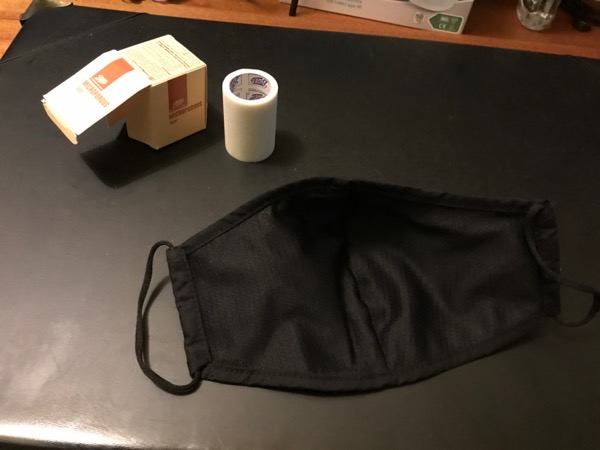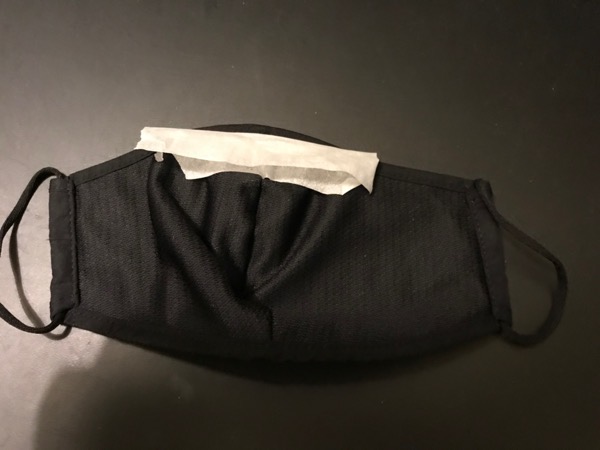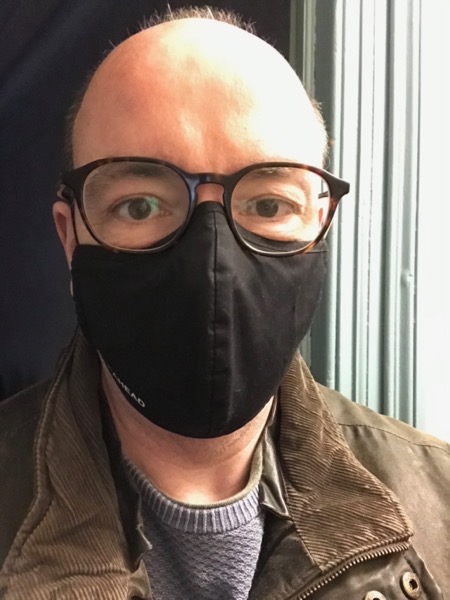Category: covid-19
You are viewing all posts from this category, beginning with the most recent.
Yesterday I tried removing my taped-on mask slowly, and it was actually much better. So I rescind my advice from the day before about removing it quickly.
Stop Your Glasses Steaming Up by Sticking the Top of Your Mask to Your Face Using Micropore Tape
The problem
If, like all sensible people, you wear a mask over your mouth and nose when you go out these days; and if, like me and millions of others, you wear glasses; then you will have experienced your breath causing your glasses to steam up.
The cause is a fundamental flaw in mask design: the mask fabric makes a straight line from our cheeks to the bridge of our noses, leaving a gap between face and mask seam. Most of our out-breaths are directed that way, just by taking the path of least resistance.
Some masks have a wire insert that lets you mould the top section around your nose. I find that improves things, but is still imperfect. There are always gaps.
The Bigger Problem
This means that the masks are not as effective as they should be for their primary purpose. All that warm, damp air that’s condensing on our glasses is also the air that might be carrying virus particles.
So while this solution helps with the steamed-up glasses problem, it also helps to make masks more effective, by ensuring that more of our potentially-poisonous breath goes through the fabric.
The Solution
It’s quite simple: apply a strip of micropore tape to the section of the mask that goes over the bridge of your nose, and seal it down well.

Micropore tape is normally used for fixing dressings on wounds, so it’s designed to stick to skin and come off with minimal fuss (though see below).
The roll we had when I thought of this is quite wide, so I’ve been folding a piece over and attaching it to the inside of the mask (at @FranChats’s suggestion).

As you can see, it’s not attached very tidily, but we’re not in this for the aesthetics.

And it’s not actually visible when the mask is on.
The New Problems: Removal, and Sensitivity
Taking the taped mask off is the worst part, in my experience. I’ve been doing it quickly: take off my glasses (otherwise they might go flying across the room); unhook the ear loops and take a firm grip of them; close my eyes; then tug sharply forward.1
It can make your eyes water, but honestly, for clear vision outside on these cold days, it’s worth it.
Removing it slowly might be better for some people. And the whole thing will not be for some. If you have very sensitive skin, or get a reaction to the adhesive, then this won’t be for you. But if you can take it, I highly recommend it.
Lastly, my pictures show a reusable mask, but it works for disposables too.
-
Though see my later post. I think I’ll be doing it slowly from now on. ↩︎
Covid Track
This is one of our local parks. Look at that desire-line track, fading into the distance (click or tap on the picture to see it bigger).

The paved footpath is off to the right. That track – a simple, direct route, that avoids the footpath – wasn’t there a year ago. The novel coronavirus changes the landscape.
People Still Aren't Getting It
I got back on the bike today. First time since I came off back in April. Both because I felt the need to add some variety to my exercise regime, and because so many people are riding these days. And also because I missed it.
It was good. Nice to be back on the bike. A bit annoying the way the mask makes your glasses steam up, but nothing that a bit of slipstream couldn’t clear.
But it was very disappointing regarding people’s behaviour. I cycled around central Hackney for half an hour or so from about 9-9:30. It was pretty busy.
I counted 11 people wearing masks (and two chin-wearers, so they don’t count). I must have passed about 500 people? 700? That’s just a guess, but it was a lot.
Eleven masks.
My mask was protecting all of them: why weren’t they protecting me, and each other?
I mainly blame the government, of course. Incoherent messaging and absence of care. But… some of us have learned what’s best, even given the government.
A Reply From the Masks Petition
That’s interesting. I don’t think I’ve had a reply like this from a UK parliament petition before:
Dear Martin McCallion,
You recently signed the petition “Make it mandatory to wear a face mask in public during Covid-19 Pandemic”: https://petition.parliament.uk/petitions/304397
The Petitions Committee (the group of MPs who oversee the petitions system) have considered the Government’s response to this petition. They felt that the response did not directly address the request of petition and have therefore written back to the Government to ask them to provide a revised response.
When the Committee have received a revised response from the Government, this will be published on the website and you will receive an email. If you would not like to receive further updates about this petition, you can unsubscribe below.
Thanks,
The Petitions team
UK Government and Parliament
– The Petitions team, Make it mandatory to wear a face mask in public during Covid-19 Pandemic
That’s from the one I linked to a week ago.
It’ll be interesting to see if we get anything more back. In the meantime, it’s still at just over 14,000 signatures: keep signing.
And keep wearing a mask.
The Monster (Wear a Mask!)
Dr Sayed Tabatabai writes beautifully about the horror of working in an ICU at the moment.
Sometimes when people sound quieter and calmer during a respiratory issue it’s a sign of impending doom.
You can’t make noise if you can’t breathe.
– Dr Sayed Tabatabai, The Monster
Go read. It’s a Twitter thread. Only 22 tweets. ThreadReaderApp doesn’t seem to be working.
And please: start wearing a face covering if you ever go out.
What Must Be Said
I hope I don’t need to say this. But silence is complicity, so:
Black Lives Matter.
My daughter went to the London demo on Wednesday (note: there was no riot, contrary to some bullshit hashtag that was trending yesterday morning). I am so proud of her. Her whole generation seem so thoughtful, so engaged.
Why didn’t I go? To be honest, it’s because I was scared. Not of the demo, or anything that might have happened there. I was scared of the virus. Of the close contact that was sure to happen.
I gave her a lift to her friend’s house. They walked for two and a half hours to Hyde Park. I picked her up in Camden afterwards. But part of me wishes I’d gone myself. She said it was a much younger crowd than the Trump or Brexit demos. Sure, it was a weekday, but more of us olds – me included – should have been there.
How Iceland Beat the Coronavirus
Great piece in The New Yorker, by Elizabeth Kolbert, about how Iceland handled the coronavirus. Which is by actually being guided by science. The experts decided what needed to happen, and it happened, without interference from politicians.
Of course, it’s a country of less than 400,000 people, so the scale is different from even the UK, never mind the US. But it does make you dream of what might have been.
We Have No Idea How Many of the Deaths Attributed to Covid-19 Really Were Due to the Disease
Dr John Lee, writing in The Spectator (paywall, but free access to a few articles), explains what pathologists do, and goes on to say:
We are still struggling to understand coronavirus. I can think of no time in my medical career when it has been more important to have accurate diagnosis of a disease, and understanding of precisely why patients have died of it. Yet very early on in the epidemic, rules surrounding death certification were changed — in ways that make the statistics unreliable.
– Dr John Lee, The way ‘Covid deaths’ are being counted is a national scandal.
We’ve moved from needing two doctors to certify death, to only one if the cause is believed to be Covid-19. And sometimes the ‘cause’ is decided from a statement from care-home staff, who are not usually trained medical professionals.
So at a time when accurate death statistics are more important than ever, the rules have been changed in ways that make them less reliable than ever. In what proportion of Covid-19 ‘mentions’ was the disease actually present? And in how many cases, if actually present, was Covid-19 responsible for death? Despite what you may have understood from the daily briefings, the shocking truth is that we just don’t know. How many of the excess deaths during the epidemic are due to Covid-19, and how many are due to our societal responses of healthcare reorganisation, lockdown and social distancing? Again, we don’t know. Despite claims that they’re all due to Covid-19, there’s strong evidence that many, perhaps even a majority, are the result of our responses rather than the disease itself.
– Dr John Lee, The way ‘Covid deaths’ are being counted is a national scandal.
It sometimes seems like we’re trying, as a country, to handle this whole thing as badly as possible.
Strange seeing this tweet from the London Cycling Campaign:
When it's safe to cycle, people cycle. #LockdownCycleFreedom https://t.co/pTrXoBkNjk
— London_cycling (@London_Cycling) May 27, 2020
Cycling is up all over, apparently. Yet I stopped cycling for fear of putting extra strain on the NHS.